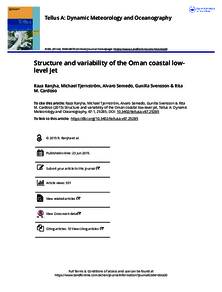Document
Global distribution and seasonal variability of coastal low-level jets derived from ERA-interim reanalysis.
Contributors
Publisher
Tellus.
Gregorian
2013-12-01
Language
English
English abstract
A low-level wind maximum is often found over the oceans near many coasts around the world. These Coastal Low-Level Jets (CLLJs) play an important role in the coastal weather and have significant impacts on regional climate and ecology as well as on a number of human activities. The presence of CLLJs is related to various local circumstances such as land-sea temperature contrasts, upwelling, coastal terrain, orientation of the coast, and so on, but also to the large-scale atmospheric dynamics. This makes studies of CLLJs not only interesting but also challenging. In this study, based on ERA-Interim reanalysis data, the global distribution, spatiotemporal structure and the seasonal variability of CLLJs are documented. Seasonal data from 1980 to 2011 are used to identify areas where CLLJs are frequently found in the lowest 2 km, following criteria based on the vertical profiles of wind speed and temperature. The results are analysed to highlight the fundamental aspects and distinctive features of the CLLJs across the globe, including their occurrence rate, jet height, maximum wind speed and horizontal extent. Global maps of CLLJs are constructed for the summer and winter seasons. The west coasts of North America, the Iberian Peninsula, north-western Africa and the south-eastern coast of the Arabian Peninsula make up the Northern Hemispheric CLLJ regions, while the west coasts of South America, Australia, and southern Africa comprise the South Hemispheric equivalents. The existence and characteristics of CLLJs along the southern coast of Oman and the western coast of the Iberian Peninsula regions are also discussed, not fully envisaged before in the context of CLLJs. The highest occurrence of CLLJs is found during the summer in both hemispheres, and the coast of Oman has the globally highest CLLJ frequency, with also the highest maximum wind speeds. The most commonly found CLLJ has a maximum wind speed between 9 and 15 ms-1, and occurs at heights between 500 and 700m a.s.l.
Member of
ISSN
0280-6495
Resource URL
Identifier
DOI: 10.3402/tellusa.v65i0.20412
Same Subject

